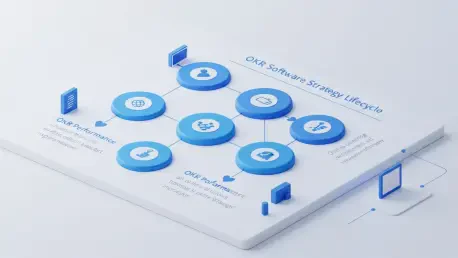As we dive into the world of organizational strategy and goal management, I’m thrilled to sit down with Marco Gaietti, a veteran in management consulting with decades of experience in business management. Marco’s expertise in strategic planning, operations, and customer relations has helped countless organizations transform their ambitions into actionable results. Today, we’ll explore how OKR (Objectives and Key Results) software platforms can bridge the gap between high-level strategy and daily execution, foster team alignment, and drive measurable progress. From the importance of real-time tracking to the features that make a platform truly effective, Marco shares his insights on how these tools can empower teams to achieve their biggest goals.
Can you walk us through what OKR software is and how it helps organizations stay focused on their goals?
OKR software is essentially a digital framework that helps companies define, track, and achieve their most critical objectives. It stands for Objectives and Key Results, where objectives are the ambitious goals you want to reach, and key results are the measurable outcomes that show you’re on track. What makes this software so powerful is its ability to bring clarity and focus to a team’s efforts. Unlike traditional tools, it doesn’t just list tasks—it ties every action to a bigger purpose, ensuring that everyone understands how their work contributes to the company’s success. For organizations, this means less wasted effort and a unified push toward what matters most.
How does OKR software stand out from regular task management tools in driving strategic impact?
Task management tools are great for organizing day-to-day work, but they often lack the strategic layer that OKR software provides. While a task tool might help you check off to-dos, OKR platforms connect those tasks directly to high-level goals. They create a visible link between, say, a marketing campaign and a revenue target, so teams see the ‘why’ behind their work. This connection fosters motivation and alignment, which task tools alone can’t achieve. Plus, OKR software often includes features like progress dashboards and goal cascading, which prioritize strategic outcomes over just getting things done.
In what ways does OKR software help tie a company’s overarching strategy to everyday workflows?
OKR software acts like a bridge between the boardroom and the front lines. It takes lofty, often abstract strategies and breaks them down into actionable steps that every team member can engage with. For instance, if a company’s strategy is to increase market share, the software helps define specific objectives for sales, marketing, and product teams, with measurable key results for each. This cascading structure ensures that daily tasks—whether it’s a sales call or a product update—directly feed into the broader vision. It eliminates the disconnect that often happens when strategy lives in static documents, making it a living part of the team’s routine.
What kind of impact does having visible goals across the organization have on team alignment?
Visibility is a game-changer for alignment. When everyone can see the company’s goals and how their own work ladders up to them, it creates a shared sense of purpose. Teams stop operating in silos and start understanding how their efforts interlink. I’ve seen cases where a development team, for example, prioritizes features because they can see how it impacts a sales goal. This transparency builds trust and accountability, as people feel their contributions are recognized as part of the bigger picture. Without it, you risk fragmented efforts where teams are busy but not necessarily moving the needle together.
Why do you consider real-time progress tracking a critical feature of OKR platforms for organizational success?
Real-time tracking shifts organizations from a reactive to a proactive stance. With live updates on goal progress, leaders and teams can see immediately if they’re on course or if something’s slipping. This means you’re not waiting for a quarterly review to realize there’s a problem—by then, it’s often too late to course-correct without significant cost. I’ve worked with companies where real-time dashboards allowed them to pivot quickly, like reallocating resources to a lagging project before it derailed a major objective. It’s about staying agile and making informed decisions in the moment, which is crucial in today’s fast-paced environments.
How does OKR software foster collaboration and break down silos within a company?
Silos are one of the biggest barriers to effective strategy execution, and OKR software tackles this by making goals and progress transparent across departments. When teams can see each other’s objectives and how they contribute to the same overarching goals, it naturally encourages collaboration. For example, I’ve seen marketing and product teams align more closely when they share a platform showing how their key results impact one another. This shared visibility prompts conversations, reduces duplicated efforts, and fosters a culture where helping another team achieve their goals feels like a win for everyone. It’s a shift from ‘my work’ to ‘our mission.’
What are some must-have features you’d recommend looking for when selecting an OKR platform?
First, goal alignment and cascading are non-negotiable. You need a platform that can visually and structurally link individual tasks to team and company objectives, so no one’s working in a vacuum. Second, progress dashboards are vital—they should offer a clear, instant view of what’s on track and what’s at risk, ideally with automated updates to save time. Lastly, collaboration tools are key. Look for features that let teams discuss goals, share feedback, and update progress right within the platform. These elements turn OKR software from a tracking tool into a dynamic hub for teamwork and strategy execution.
How have you seen OKR platforms transform the way organizations approach goal-setting and achievement over the years?
Over the years, I’ve witnessed OKR platforms evolve from niche tools to central drivers of organizational performance. Initially, goal-setting was often a top-down, infrequent exercise—think annual reviews or static spreadsheets. But with OKR software, it’s become a continuous, inclusive process. Teams now set quarterly or even monthly goals with clear metrics, and the software ensures everyone stays engaged through regular check-ins and updates. I’ve seen companies move from vague aspirations to precise, measurable outcomes, with teams feeling more empowered because they can see their impact in real time. It’s transformed goal-setting from a chore into a motivating rhythm.
What advice do you have for our readers who are just starting to explore OKR software for their teams?
My advice is to start small and focus on adoption. Don’t try to overhaul everything at once—pick a pilot team or department to test the software and refine your approach. Make sure the platform you choose integrates with your existing workflows, so it feels like a natural addition rather than an extra burden. Also, invest time in training and communicating the ‘why’ behind using OKRs. When people understand how it connects their work to the company’s success, they’re more likely to embrace it. Finally, keep it simple at first—focus on a few clear objectives and measurable results, then scale up as your team gets comfortable. It’s all about building momentum.









